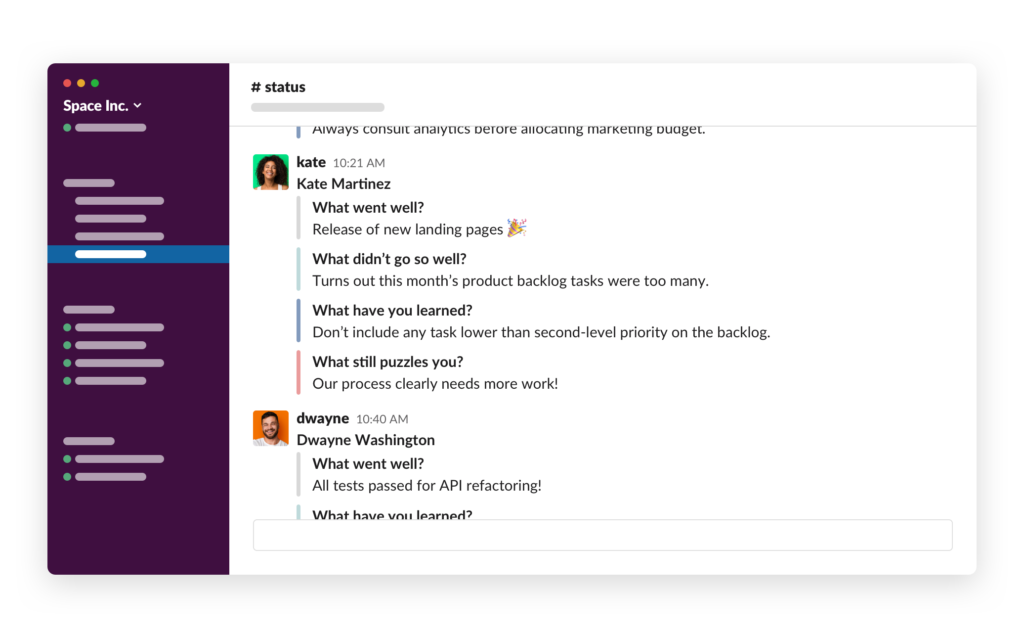A well-organized retrospective is a big productivity hack for your entire Scrum team. Do retrospectives the right way and your team will become more effective with every agile sprint. Do retrospectives the wrong way… And your whole team starts feeling that the retrospective is just another mindless meeting that everyone has to get through at the end of the week.
Fortunately, there’s a way to consistently engage your team members and at the same time ensure you get the most out of every retrospective by having sprint retrospective games. With agile retrospective games you can set team members at ease, facilitate deep discussions, and turn insights into actionable steps.
Let’s cover the most effective and fun retrospective games that you can conduct at the beginning, during, and at the end of your retrospectives.

Note: If you want to run effective scrum retrospectives and daily standups directly through Slack and keep your level of team collaboration and engagement at an all-time high, try the 30-day trial Geekbot.
Games At The Beginning Of Retrospective
Retrospective games at the beginning of the meeting serve either as a virtual team ice breaker or as a way to gauge how the team feels about retrospectives in general.
Let’s cover these games in detail.
#1: ESVP
ESVP (Explorers, Shoppers, Vacationers, Prisoners) is a popular retrospective game that was featured in a widely popular book “Agile Retrospectives: Making Good Teams Great” written by Esther Derby and Diana Larsen.
During this game every participant reports their attitude towards the retrospective as either Explorer, Shopper, Vacationer, or Prisoner.
Explorers want to discover new ideas and insights.
Shoppers analyse information and want to learn at least one useful idea during the realtor meeting.
Vacationers aren’t interested in retrospectives, but like being away from the daily grind.
Prisoners feel forced to attend the meeting and would prefer doing something else.
How to play ESVP:
- Explain that you want to collect information on how people view retrospective in the team
- Describe the ESVP roles to everyone attending the retro meeting.
- Collect anonymous feedback from everyone by distributing slips of paper or using online retrospective tools and polls.
- Let every employee briefly discuss their attitude towards a retro and assign their feedback to one of the roles.
- Analyse the collected feedback to see how many Explorers, Shoppers, Vacationer, and Prisoners there are in your group.
ESVP retrospective games are critical for conducting effective retrospectives. If you see that the majority of your attendees are Prisoners or Vacationers make sure to discuss this with your team before moving on, as there’s no point in discussing team problems when the majority of your team would like to be elsewhere.
#2: Symbolic Sprint
A great ice breaker before the actual retrospective starts is to ask your team to describe the latest sprint using symbolic representations.
How to play Symbolic Sprint:
Ask all your team members to describe the latest sprint as:
- A movie name
- A car brand
- A superhero or a supervillain
- A historical event
For example, one of your team members might jokingly label the latest sprint as “The Fall of the Berlin Wall,” whereas their teammate would rather use the “Mayflower Expedition” comparison. Ask participants why they picked a certain event or symbol and you’ll be amazed by the insights that might follow.
This game allows team members to talk about certain problems indirectly and facilitates less filtered feedback. Also it’s a funny and creative way to kickstart your meeting and set everyone at ease.
#3: Truths And Lies
This game is recommended for more experienced Scrum teams with high levels of trust.
How to Play Truth And Lies:
Every team member comes up with three statements about the team, sprint, or anything you decide relevant to your team performance. But here’s the catch: two of these statements should be truthful, and one — false.
Team members then share their three statements with the rest of the team. The team should collectively guess which statement is false.
Watch closely for the statements that are debated the most as those indicate what issues in your team are the most contradictory and may potentially cause extra friction within the team in the future.
#4: That Person and This Person
That Person and This Person is a great team-building activity that guides participants toward acceptable and unacceptable team behaviour. Framing behaviour this way and including examples makes discussion easier.
How to run That Person and This Person:
- Separate a canvas into two areas, the first with the sentence “Don’t be ‘that person’” and the second with “This person rocks!”. This can be a digital or physical board.
- Get participants to write comments and group them under the categories from before. “That person” is not a team player, while “This person” is a fantastic team player who everyone wants on their team.
- Discuss the notes and group similar traits from each category together.
Games During Sprint Retrospective
The primary goal of the agile retrospective games that are conducted during the retrospective is to gather as many insights into team performance and struggles as possible for future analysis.
Issues such as low trust environment, poor management, and low level of engagement prevent team members from sharing their feedback. The following games are designed to elicit the most honest and actionable feedback from participants.
#5: Mad Sad Glad
This “Mad Sad Glad” is probably the most common scrum retrospective game.
The goal of the game is to gather feedback from participants and at the same time gauge their feelings about the process.

How to play Mad Sad Glad:
Take three pieces of paper and label them as “Mad”, “Sad”, and “Glad”. If you are conducting an online retrospective, you can use Trello or online retrospective tools and create three columns with the same names instead.
Ask every team member to write at least one thing for every column, and then group similar issues into clusters.
After that, discuss the clusters of issues by asking your team the following questions:
- What are the most prominent issues for you on this board?
- What did you not expect to see?
- Do you notice any patterns?
- What do you think should be our next steps?
#6: Wow, Wondering, Worried
This graph-like retrospective game allows teams to laser-focus their attention on specific issues.
For example, teams can evaluate how they conduct meetings or how they foster relationships with outside stakeholders.
How to play Wow, Wondering, Worried
Create a graph with a horizontal axis depicting workflows or items you want to rate and vertical axis with three predefined labels: Worried, Wondering, or Wow.
Team members then need to rate every item on the horizontal axis.
In the end you’ll have a visual representation of what your team thinks about every meeting or item on the X axis.
For example, seeing the amount of “worried dots” at “Daily” you might notice that the team is largely concerned about daily standups.
Upon further investigation you can learn that the team thinks that daily standups are ineffective and exhaustive, and start looking for a solution.
#7: 2×2
2×2 is both an extremely versatile and engaging game to collect feedback from your team members. The best part is that you can change the format every retrospective to keep your meetings fun and engaging.
How to play 2×2:
To play 2×2, simply draw a two-on-two box and fill every section with an emoji, a symbol, or a word that can describe what team members think about your process. Play around with ideas!
For example, use four architectural monuments and ask your team members what felt like building a pyramid during the sprint or ended up being your fabulous Taj Mahal. Or go with animals: what was your slow turtle, your mighty lion, a slimy snake, or a lost puppy.
The goal here is to get your team creative and facilitate the process of sharing ideas in a new and fun way.
Ask every team member to write at least one card for every section and then analyse their feedback. You don’t have to use the same labels every time, so feel free to experiment to keep things fresh.
#8. Team Radar
Team Radar helps teams gauge how they’re doing on a variety of measures by turning participant insights into a visual aid.

How to play Team Radar:
- Begin by introducing the factors to be measured. Ask the team to assess the factors by rating them on a scale from 0 to 10. Zero means that they’re not doing well at all, while 10 means they’re doing as well as they possibly can.
- Put the ratings on a blank radar graph and discuss how these factors affect the team’s work. You can use questions like:
- Where are we following these [fill in factors]?
- Where are we not following these [fill in factors]?
- Save or screenshot the completed flip chart graph. Run the game again two or three sprints later. Compare the two charts as a progress measurement.
#9. Locate Strengths
As an interviewing game, Locate Strengths lets team members reflect upon their projects and identify strengths so the team can build on them in the next sprint.
How to play:
- Form pairs and get them to interview each other. Encourage them to listen to each other and make notes. Ask questions like these:
- What attracted you to the company/profession?
- What was a high point during the last project where you felt you were at your best?
- What made it a high point? What were the circumstances and who else was present?
- Do you have any wishes for future projects?
- Once the interviews are complete, form groups and discuss any common themes and ideas derived from the interviews. Groups can break out into smaller groups to refine their thoughts.
Games At the End Of Retrospective
Properly ending the retrospective is as crucial as starting or conducting it. The main objective at the end of the retrospective is to come up with an actionable list of items that the team can execute during the next sprint to improve their efficiency.
The following agile games will help Scrum teams to become more focused, to put previously gathered data to action, and to end retrospective on a positive note.
#10: SMART Planning
Often the problem with retrospectives is that they are not actionable: people just meet, talk about issues, and leave it at that. The SMART planning aims to help people design improvement plans that can be executed during the next sprint.
How to play SMART Planning:
Simply share with your team the image that explains what SMART goals are and ask team members to propose SMART actions that can improve the team’s performance during the next sprint.
After that put all the SMART actions into one place, group similar actions and prioritise those that your team aims to execute next. Save the list for the next retrospective to discuss your progress and execution.
#11: Return of Time Invested
Return of Time Invested is designed to help agile teams to assess whether their retrospectives are productive.
How to play Return of Time Invested:
Draw a chart and ask your team to indicate how useful and actionable the current retrospective was in terms of finding issues, gathering feedback, and general organization.
To elicit more honest feedback explain that there won’t be any discussion about the chart and you will simply use this data for future comparison.
The chart works best when compared to charts from previous sessions and used for checking the positive or negative dynamics over time. The findings can be later used for cross-checking results with ESVP or during the “Wow, Wondering, Worried” game.
#12: Letters to the future
General feeling of purpose increases your team productivity. “Letter to the future” game helps teams to look beyond the current issues and environment when writing about their performance.
How to play Letters to the future:
Ask participants to write a letter on how they see their team performance in one month or three months. Try focusing on the positive outcomes, e.g. the finished project, or a yearly team offline meeting.
Note that you should not share these letters with others at the beginning. After the project ends you can read out the letters if the person who wrote it agrees.
#13. Temperature Reading
Temperature Readings helps teams set the stage before a retrospective or calibrate after by combining positive feedback, constructive comments, information and aspiration into a nifty package.
How to play Temperature Reading:
- Get the team to comment on each Temperature Reading element within the context of the meeting:
- Appreciations – notice how others have contributed
- Puzzles – things the participant doesn’t understand or is curious about
- Complaints with Recommendations – things the participant would like to be different
- New Information – share information that may be relevant
- Hopes & Wishes – what the participant hopes for during or after the retrospective
- Each participant can contribute to any of the sections or none at all, but the focus should be on hearing and recording what everyone has to say.
#14: Dealing with Failure
This activity is great for retrospectives following up on a failure, as it helps teams systematically analyse what might have contributed to the failure occurring.
How to play Dealing with Failure:
- Describe the failure and summarise it on top of a digital or physical canvas.
- Divide the canvas into four areas:
- Analysis – What is the failure and what led to it?
- Evaluation – What are the consequences and their severity? What are the chances of this happening again?
- Action – What can be done to correct and prevent this failure from happening again?
- Verification – How can the action outcomes above be verified?
- Make groups of two to three people and give them some time to write down their thoughts, then discuss in a larger group.
#15: One Question
One Question is a great game for ending your retrospectives on a positive note.
How to play One question:
The crucial detail about this game is that the question should be framed positively. For example, ask participants to share one thing they improved during the last sprint or ask them to give praise to one of their team members.
Closing retrospective on a positive note helps team members to associate retrospectives with positive experiences and frame retros as an improvement-related rather than a problem-oriented discussion.
We hope that these retrospective sprint games will help you make your retro meetings more productive and colourful. Don’t hesitate to mix them with your workflow or adjust them to your needs.
If you are a remote team and want to have focused and engaging daily standup meetings directly in your Slack, try Geekbot free for 30 days!
Frequently asked questions
How do you make a retrospective fun?
Retrospective games are the most effective way to make your retrospectives fun, engaging, and refreshing. There are many retrospective games you can use to bring life to your retrospective. Experiment with different formats and analyze which ones are the best fit for your particular team. With time you can learn the underlying mechanisms behind successful retro games and come up with your formats.
How do you make a good retro?
A good retrospective is concise, engaging, and actionable. To make your retros short, facilitate only relevant discussion around specific issues and promote actionable feedback rather than abstract discussion. To make your retro engaging, set team members at ease with retro games and well-being surveys. To make your retro actionable, facilitate actionable output whenever you can and wrap up your retro with a written list of items to pursue during the next sprint.
What are the activities you do in the sprint retrospective meeting?
A typical sprint retrospective meeting consists of four parts: warm-up, data gathering, data analysis, and actionable output production. During warm-up, you can ask icebreakers questions, praise achievements, or survey team mood. During the data-gathering stage, you employ various methods to collect honest feedback from your team members. After analyzing insights, your goal is to collectively produce a list of actionable items that improve your next sprint’s performance.



